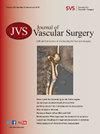The impact of travel distance in patient outcomes following revascularization for chronic limb-threatening ischemia
IF 3.9
2区 医学
Q1 PERIPHERAL VASCULAR DISEASE
引用次数: 0
Abstract
Background
Patient travel distance to the hospital is a key metric of individual and social disadvantage and its impact on the management and outcomes following intervention for chronic limb-threatening ischemia (CLTI) is likely underestimated. We sought to evaluate the effect of travel distance on outcomes in patients undergoing first-time lower extremity revascularization at our institution.
Methods
We retrospectively reviewed all consecutive patients undergoing first-time lower extremity revascularization, both endovascular and open, for CLTI from 2005 to 2014. Patients were stratified into 2 groups based on travel distance from home to hospital greater than or less than 30 miles. Outcomes included reintervention, major amputation, restenosis, primary patency, wound healing, length of stay, length of follow-up and mortality. Kaplan-Meier estimates were used to determine event rates. Logistic and cox regression was used to evaluate for an independent association between travel distance and these outcomes.
Results
Of the 1293 patients were identified, 38% traveled >30 miles. Patients with longer travel distances were younger (70 years vs 73 years; P = .001), more likely to undergo open revascularization (65% vs 41%; P < .001), and had similar Wound, Ischemia, foot Infection stages (P = .404). Longer distance travelled was associated with an increase in total hospital length of stay (9.6 days vs 8.6 days; P = .031) and shorter total duration of postoperative follow-up (2.1 years vs 3.0 years; P = .001). At 5 years, there was no definitive difference in the rate of restenosis (hzard ratio [HR], 1.3; 95% confidence interval [CI], 0.91-1.9; P = .155) or reintervention (HR, 1.4; 95% CI, 0.96-2.1; P = .065), but longer travel distance was associated with an increased rate of major amputation (HR, 2.1; 95% CI, 1.2-3.7; P = .011), and death (HR, 1.6; 95% CI, 1.2-2.2; P = .002). Longer travel distance was also associated with higher rate of nonhealing wounds (HR, 2.3; 95% CI, 1.5-3.5; P = .001).
Conclusions
Longer patient travel distance was found to be associated with a lower likelihood of limb salvage and survival in patients undergoing first-time lower extremity revascularization for CLTI. Understanding and addressing the barriers to discharge, need for multidisciplinary follow-up, and appropriate postoperative wound care management will be key in improving outcomes at tertiary care regional specialty centers.
旅行距离对慢性肢体缺血血管重建术后患者疗效的影响。
简介患者前往医院的距离是衡量个人和社会劣势的一个关键指标,其对慢性肢体缺血干预后的管理和疗效的影响很可能被低估。我们试图评估本院首次接受下肢血管重建术的患者的旅行距离对治疗效果的影响:我们回顾性地检查了 2005 年至 2014 年期间因 CLTI 而首次接受下肢血管重建手术(包括血管内和开放手术)的所有连续患者。根据患者从家到医院的距离大于或小于30英里,将患者分为两组。结果包括再介入、重大截肢、再狭窄、初次通畅、伤口愈合、住院时间、随访时间和死亡率。采用 Kaplan-Meier 估计法确定事件发生率。采用 Logistic 和 Cox 回归评估旅行距离与这些结果之间的独立关联:在 1293 名患者中,38% 的患者旅行距离超过 30 英里。旅行距离较远的患者更年轻(70 岁对 73 岁,P=0.001),更有可能接受开放性血管再通手术(65% 对 41%,PConclusions):研究发现,对于因慢性肢体缺血而首次接受下肢血管重建术的患者来说,较长的旅行距离与较低的肢体挽救和存活率有关。了解并解决出院障碍、多学科随访需求以及适当的术后伤口护理管理将是改善三级医疗区域专科中心治疗效果的关键。
本文章由计算机程序翻译,如有差异,请以英文原文为准。
求助全文
约1分钟内获得全文
求助全文
来源期刊
CiteScore
7.70
自引率
18.60%
发文量
1469
审稿时长
54 days
期刊介绍:
Journal of Vascular Surgery ® aims to be the premier international journal of medical, endovascular and surgical care of vascular diseases. It is dedicated to the science and art of vascular surgery and aims to improve the management of patients with vascular diseases by publishing relevant papers that report important medical advances, test new hypotheses, and address current controversies. To acheive this goal, the Journal will publish original clinical and laboratory studies, and reports and papers that comment on the social, economic, ethical, legal, and political factors, which relate to these aims. As the official publication of The Society for Vascular Surgery, the Journal will publish, after peer review, selected papers presented at the annual meeting of this organization and affiliated vascular societies, as well as original articles from members and non-members.

 求助内容:
求助内容: 应助结果提醒方式:
应助结果提醒方式:


